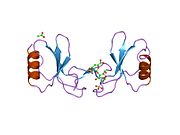-
1b3a: Totalna hemijska sinteza i kristalna struktura u visokoj rezoluciji potentnog anti-HIV proteina AOP-RANTES
CCL5
CCL5, hemokin (C-C motiv) ligand 5, takođe poznat kao RANTES (engl. Regulated upon Activation, Normal T-cell Expressed, and Secreted) je protein koji je kod ljudi kodiran CCL5 genom.[1][2]
Funkcija
[уреди | уреди извор]CCL5 je 8 kDa protein koji je klasifikovan kao hemotaksni citokin ili hemokin. CCL5 je hemoatraktant T ćelija, eozinofila, i bazofila. On učestvuje u regrutovanju leukocita na mesta zapaljenja. Uz pomoć određenih citokina (npr., IL-2 i IFN-γ) koji se oslobađaju iz T ćelija, CCL5 takođe stimuliše proliferaciju i aktivaciju pojedinih tipova (NK) ćelija da formiraju CHAK (CC-hemokin-aktivirane ubice) ćelije.[3] CCL5 je takođe HIV-supresivni faktor koji izlučuju CD8+ T ćelije. Gen ovog hemokina je lociran na hromozomu 17 kod ljudi.[4]
RANTES je prvobitno bio identifikovan u toku potrage za "kasno" izraženim genima (3–5 dana) nakon T ćelijske aktivacije. Naknadno je bilo utvrđeno da je on CC hemokin i da je izražen u više od 100 ljudskih bolesti. RANTES izražavanje je regulisano u T limfocitima Krupel sličnim faktorom 13 (KLF13).[5][6][7][8]
Interakcije
[уреди | уреди извор]Za CCL5 se zna da formira interakcije sa CCR3,[9][10] CCR5[10][11][12] and CCR1.[10][12]
CCL5 takođe aktivira G-protein spregnuti receptor GPR75.[13]
Vidi još
[уреди | уреди извор]Reference
[уреди | уреди извор]- ^ Donlon TA, Krensky AM, Wallace MR, Collins FS, Lovett M, Clayberger C (1990). „Localization of a human T-cell-specific gene, RANTES (D17S136E), to chromosome 17q11.2-q12”. Genomics. 6 (3): 548—53. PMID 1691736. doi:10.1016/0888-7543(90)90485-D.
- ^ Mire-Sluis, Anthony R.; Thorpe, Robin, ур. (1998). Cytokines (Handbook of Immunopharmacology). Boston: Academic Press. ISBN 0-12-498340-5.
- ^ Maghazachi; et al. (1996). „CC chemokines induce the generation of killer cells from CD56+ cells”. Eur J Immunol. 26: 315—9. PMID 8617297.
- ^ Donlon; et al. (1990). „Localization of a human T-cell-specific gene, CCL5 (D17S136E), to chromosome 17q11.2-q12.”. Genomics. 5: 548—553. PMID 1691736.
- ^ Schall TJ, Jongstra J, Dyer BJ, Jorgensen J, Clayberger C, Davis MM, Krensky AM (1988). „A human T cell-specific molecule is a member of a new gene family”. J. Immunol. 141 (3): 1018—25. PMID 2456327.
- ^ Krensky, Alan M. (1995). Biology of the Chemokine in Rantes (Molecular Biology Intelligence Unit). R G Landes Co. ISBN 978-1-57059-253-9.
- ^ Song A, Chen YF, Thamatrakoln K, Storm TA, Krensky AM (1999). „RFLAT-1: a new zinc finger transcription factor that activates RANTES gene expression in T lymphocytes”. Immunity. 10 (1): 93—103. PMID 10023774. doi:10.1016/S1074-7613(00)80010-2.
- ^ Song A, Nikolcheva T, Krensky AM (2000). „Transcriptional regulation of RANTES expression in T lymphocytes”. Immunol. Rev. 177: 236—45. PMID 11138780. doi:10.1034/j.1600-065X.2000.17610.x.
- ^ Daugherty BL, Siciliano SJ, DeMartino JA, Malkowitz L, Sirotina A, Springer MS (1996). „Cloning, expression, and characterization of the human eosinophil eotaxin receptor”. J. Exp. Med. 183 (5): 2349—54. PMC 2192548
 . PMID 8642344.
. PMID 8642344.
- ^ а б в Struyf S, Menten P, Lenaerts JP, Put W, D'Haese A, De Clercq E, Schols D, Proost P, Van Damme J (2001). „Diverging binding capacities of natural LD78beta isoforms of macrophage inflammatory protein-1alpha to the CC chemokine receptors 1, 3 and 5 affect their anti-HIV-1 activity and chemotactic potencies for neutrophils and eosinophils”. Eur. J. Immunol. 31 (7): 2170—8. PMID 11449371. doi:10.1002/1521-4141(200107)31:7<2170::AID-IMMU2170>3.0.CO;2-D.
- ^ Slimani H, Charnaux N, Mbemba E, Saffar L, Vassy R, Vita C, Gattegno L (2003). „Interaction of RANTES with syndecan-1 and syndecan-4 expressed by human primary macrophages”. Biochim. Biophys. Acta. 1617 (1-2): 80—8. PMID 14637022.
- ^ а б Proudfoot AE, Fritchley S, Borlat F, Shaw JP, Vilbois F, Zwahlen C, Trkola A, Marchant D, Clapham PR, Wells TN (2001). „The BBXB motif of RANTES is the principal site for heparin binding and controls receptor selectivity”. J. Biol. Chem. 276 (14): 10620—6. PMID 11116158. doi:10.1074/jbc.M010867200.
- ^ Ignatov A, Robert J, Gregory-Evans C, Schaller HC (2006). „RANTES stimulates Ca2+ mobilization and inositol trisphosphate (IP3) formation in cells transfected with [[G protein spregnuti receptori|G protein-coupled receptor]] 75”. Br. J. Pharmacol. 149 (5): 490—7. PMC 2014681
 . PMID 17001303. doi:10.1038/sj.bjp.0706909. Сукоб URL—викивеза (помоћ)
. PMID 17001303. doi:10.1038/sj.bjp.0706909. Сукоб URL—викивеза (помоћ)
Literatura
[уреди | уреди извор]- Muthumani K; Desai BM; Hwang DS; et al. (2004). „HIV-1 Vpr and anti-inflammatory activity.”. DNA Cell Biol. 23 (4): 239—47. PMID 15142381. doi:10.1089/104454904773819824.
- Zhao RY, Elder RT (2005). „Viral infections and cell cycle G2/M regulation.”. Cell Res. 15 (3): 143—9. PMID 15780175. doi:10.1038/sj.cr.7290279.
- Zhao RY, Bukrinsky M, Elder RT (2005). „HIV-1 viral protein R (Vpr) & host cellular responses.”. Indian J. Med. Res. 121 (4): 270—86. PMID 15817944.
- Li L; Li HS; Pauza CD; et al. (2006). „Roles of HIV-1 auxiliary proteins in viral pathogenesis and host-pathogen interactions.”. Cell Res. 15 (11-12): 923—34. PMID 16354571. doi:10.1038/sj.cr.7290370.
- Krensky, Alan M. (1995). Biology of the Chemokine in Rantes (Molecular Biology Intelligence Unit). R G Landes Co.











